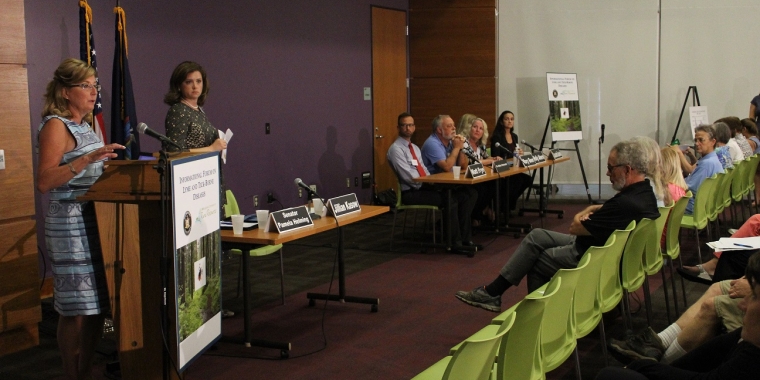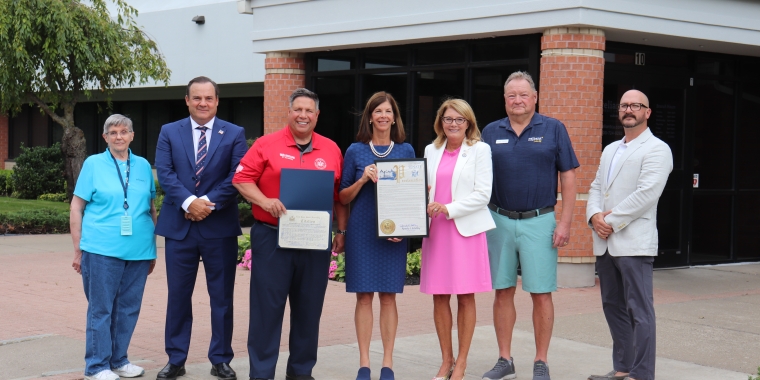
Senator Helming Leads Lyme and Tick-Borne Diseases Forum
Jonathan Monfiletto - 315-568-9816
September 28, 2017
-
ISSUE:
- Lyme and Tick-Borne Diseases

Senator Pam Helming hosted the Informational Forum on Lyme and Tick-Borne Diseases at Finger Lakes Community College in Canandaigua on Tuesday, Sept. 26.
The featured speakers were Dr. Matt Frye, an extension educator with the New York State Integrated Pest Management Program at Cornell University; Dr. Robert Ostrander, associate professor in the Department of Family Practice at SUNY Upstate Medical University, member of the New York State Rural Health Council, and former President of the New York State Academy of Family Physicians; Ontario County Public Health Director Mary Beer; Holly Ahern, associate professor of microbiology at SUNY Adirondack and Vice President of the Lyme Action Network; and Dr. Cassandra Guarino, extension associate for serology and immunology for the Animal Health Diagnostic Center at the Cornell University College of Veterinary Medicine. There were also information tables from Cornell University and the public health departments from Wayne, Seneca, and Ontario counties that offered tick removal kits for attendees to take home.
Approximately 200 people attended the first informational meeting on Lyme and tick-borne diseases that Senator Helming, a member of the New York State Senate Task Force on Lyme and Tick-Borne Diseases, held in her district. She previously took part in a public hearing in Albany that the Task Force conducted in August. During her opening remarks, Senator Helming asked the people in attendance to raise their hands if they have Lyme or a tick-borne disease or know someone who does. She pointed out that the majority of the people raised their hands.
“That shows how important it is that we continue to offer forums such as this so that we can raise awareness and increase education about Lyme and tick-borne diseases. These diseases are often contracted through something as simple as a walk in the woods on a sunny day, but they can have debilitating consequences that can last a lifetime. It was great to see such a large turnout of patients, families, advocates, health professionals, and others who are interested in learning more. We must work together to address this problem that is making its way through the Finger Lakes region and spreading across New York State,” Senator Helming said.
Dr. Frye titled his presentation “Debunking the Myths” and highlighted some of the common misconceptions about ticks and the diseases they carry. He emphasized that more ticks are being found in more places and that the tick season is starting earlier and lasting longer, leading to greater exposure for people and animals. He said if people took precautions, the incidences of Lyme and tick-borne diseases would be limited.
In a talk titled “Working With Your Physician,” Dr. Ostrander noted that he is personally recovering from Lyme disease and has experience as a physician who sees patients who may have a tick-borne disease. He spoke about the common phone calls and office visits that he encounters, such as people asking about the correct way to remove a tick and the type of rash that would signal a tick-borne disease. He also touched on the clinical factors and resources that are used to make a diagnosis.
Director Beer pointed out that 42 confirmed cases of Lyme disease have occurred in Ontario County so far this year and that the number is likely to keep going up in the future. She talked about some of the ways to prevent Lyme and tick-borne diseases, such as avoiding wooded and brushy areas, walking in the center of trails, checking one’s full body as well as children for ticks, removing ticks with tweezers, and looking for early symptoms.
Through an interactive quiz for the audience, Professor Ahern highlighted what some of the medical and scientific literature says about Lyme and tick-borne diseases. She also provided suggestions for working toward solving issues related to these diseases: recognition of the latest scientific evidence, research to discover more accurate diagnostic tests and effective treatment, research to discover effective ways to decrease human exposure to ticks, and legislative leadership to assure patients the right to a reasonable level of medical care.
Dr. Guarino spoke about Lyme and tick-borne diseases in livestock and pets. She talked about the symptoms of these diseases in dogs while noting that cats do not typically contract them. Similarly, she said horses can get Lyme and tick-borne diseases but noted that cattle typically do not. She also spoke about Cornell University’s tick testing program, where individuals can submit up to six ticks for testing at a time.
“I appreciated hearing our panelists talk about what we need to do to address the problem of Lyme and tick-borne diseases, but it also takes funding to combat this epidemic. One of the things the Senate Task Force is working on is increasing funding for research and resources. We understand it is going to take more resources to get the research done and find the right solutions, so that is what we will be fighting for in the coming year,” Senator Helming said.
After the speakers finished their presentations, Senator Helming conducted a 30-minute question-and-answer session with audience members and panelists.
“The information on Lyme and tick-borne diseases is constantly evolving as we learn more about them. I will continue to work closely with the Senate Task Force to provide the most reliable, up-to-date information available. We must continue to work toward bringing more awareness to this important issue,” Senator Helming said.
Senator Helming represents the 54th Senate District, which consists of Seneca and Wayne Counties, parts of Cayuga and Ontario Counties, and the towns of Lansing and Webster. For more information, please visit Senator Helming’s website, or follow @SenatorHelming on Facebook or Twitter.
###
Share this Article or Press Release
Newsroom
Go to Newsroom
Letter to DEC Re: Paper Sporting Licenses
August 28, 2024
Column: Let Girls Play
August 23, 2024

Electronic Recycling Event
August 19, 2024
